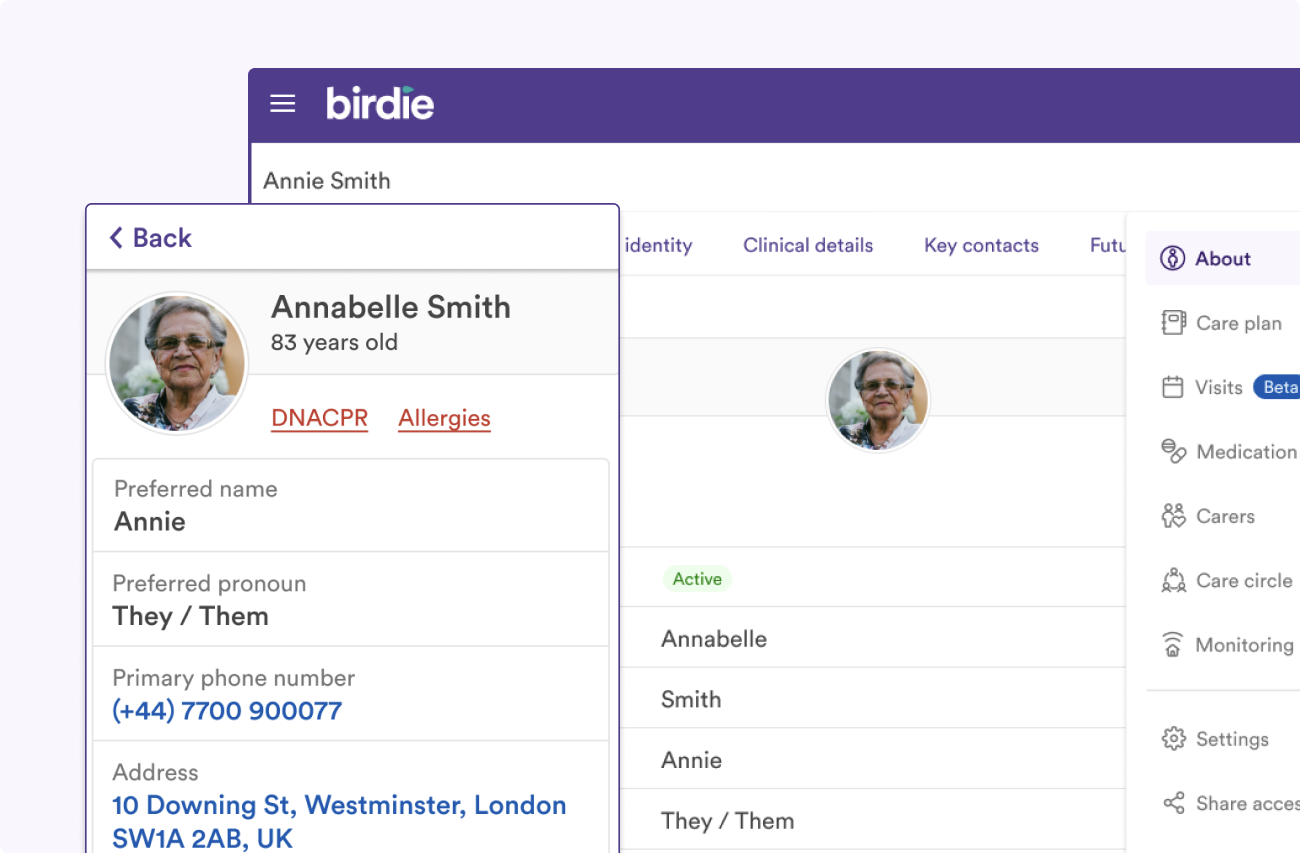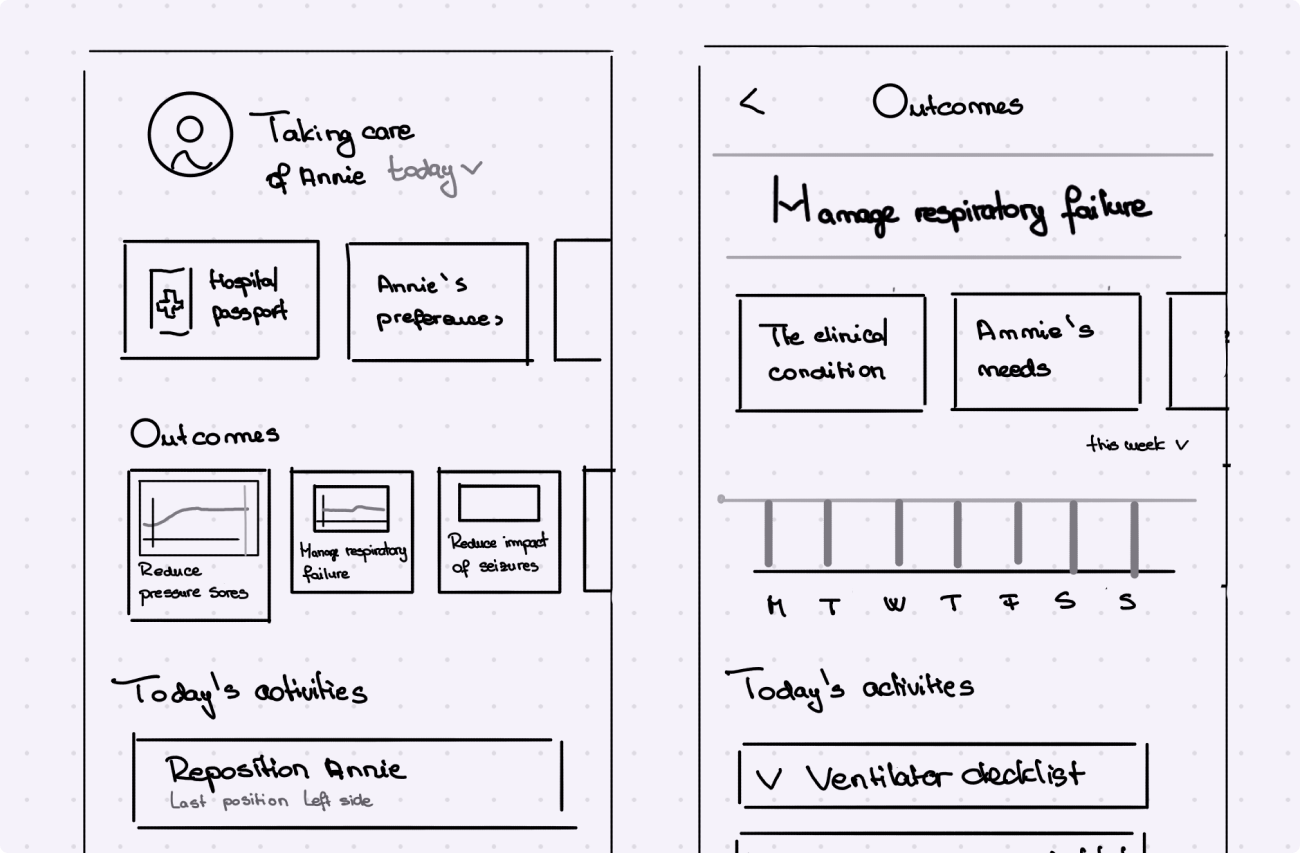About me
Context
I contributed to shaping Birdie’s vision of outcome-based care, shifting the focus from simply delivering hours of care to enabling independence and better quality of life for individuals. As part of this vision, we worked towards empowering care agencies to deliver quality over quantity. One significant milestone in this journey was the creation of the first person-centered care plan, starting with the About Me feature, which is the focus of this project.
Problem
The business and product goals were clear:
- Business Goal: Align Birdie Care Plan with person-centered care principles and Care Quality Commission (CQC) guidelines.
- Product Goal: Balance structured data necessary for preventative care with the dignity and individuality of older adults.
Care agencies were struggling with poor CQC ratings, often due to gaps in personal identity information in their data capture processes. This lack of emphasis on personal identity not only affected compliance but also failed to respect the individuality of older adults.
Key Question:
How might we address this gap while maintaining dignity and respect for older adults?

Process
We followed a standard product development process:
- Research: Conducted user interviews with key stakeholders, including caregivers and agency managers, to understand needs and pain points. We also performed desktop research to evaluate CQC guidelines and studied existing frameworks like This is me by the Alzheimer’s Society.
- Design & Testing: Prototyped and tested mockups iteratively, ensuring alignment with compliance standards and usability for care workers.
While this process was critical, what stood out was our application of Moral Creativity to guide ideation and ensure ethical, impactful design.


This approach guided us through three key lenses:
1. Intention: Virtue Ethics
An action is morally right when it reflects what a virtuous person would do.
The focus here was on ensuring that capturing sensitive data about older adults was driven by ethical intentions and guided by virtuous behavior.
- Virtuous Assessor:
✅ Would capture sensitive data only if it directly informs care needs, adhering to GDPR standards.
✅ Would ensure older adults willingly share such information, fostering trust and dignity.
✅ Would guarantee this information is never misused to discriminate. - Immoral Assessor:
❌ Might capture unnecessary sensitive data for the sake of it, violating privacy.
❌ Might gather data without the older adult’s consent, breaching ethical trust.
❌ Might use sensitive data to discriminate against the older adult, family, or workforce.
Mitigations Built into the Design:
- Warn users to ensure a lawful basis for collecting sensitive information (e.g., consent + relevance).
- Require users to upload consent before adding sensitive data.
- Ensure captured preferences explicitly connect to how they benefit care, promoting respect and dignity.
2. Design: Deontology
An action is morally right if it adheres to moral rules and duties.
In this lens, the design aligned with CQC moral rules to ensure compliance with ethical care principles.
- CQC Guidelines Reflected in the Design:
🟠 Safe: Protect individuals from discrimination and harassment through secure data handling.
🟠 Effective: Incorporate cultural preferences into care decisions.
🟠 Caring: Ensure care is culturally sensitive and respectful of personal preferences.
🟠 Responsive: Provide tools and training to meet diverse needs.
🟠 Well-led: Foster a positive, inclusive, and person-centered care culture.
Design Features Supporting These Guidelines:
- Structured forms with prompts to capture culturally significant information.
- Clear UX language reinforcing that preferences must align with delivering better care.
- Features promoting inclusivity, such as options to express identity beyond standard categories.
3. Effect: Consequentialism
An action is morally right if it produces the best outcomes for the most people.
This lens focused on achieving positive outcomes for both older adults and care professionals.
- Good Effects:
🟠 Older adults feel respected and treated with dignity.
🟠 Care professionals deliver person-centered care that considers individual preferences and needs.
Design Features Supporting Positive Outcomes:
- Information is accessible in multiple formats (tablet-friendly, mobile-responsive, printable PDFs).
- Care teams can easily share the information with colleagues to ensure seamless care.
- Older adults receive information in their preferred format, enabling active participation in their care.

Outcome
The resulting About Me feature allowed care agencies to capture personal stories, preferences, and identities of the people they cared for, blending structured data with respect for individuality. It became a foundational step towards Birdie’s broader mission of enabling care agencies to deliver outcome-based care.




Success Metrics
The “About Me” feature unlocked key customers and, most importantly, promoted inclusivity.
Key Successes:
- Customer Empowerment:
This story highlights how the feature allowed individuals to express their identity, fostering a more inclusive and personal care experience. - Business Growth:
By aligning with CQC guidelines and offering personalised care, we attracted key customers, driving business growth and expanding our reach.



Challenges in Adoption
- Agency Resistance to Standardization:
Many agencies were protective of their unique care plans, reluctant to adopt a standardized approach. This slowed down implementation of the “About Me” feature. - Preference for PDFs:
Some agencies preferred uploading care plans as PDFs, which limited the system’s ability to map data and suggest actionable outcomes, instead of just listing tasks.
Solutions:
We introduced a smart PDF upload feature that automatically extracted details and populated the structured form, making it easier for agencies to transition. This, combined with strong storytelling, helped overcome adoption challenges and demonstrate the long-term benefits of structured, data-driven care plans.

Future Vision and Milestones
The “About Me” feature aims to evolve care planning from a task list to a holistic approach, where each aspect of an individual’s identity shapes their care. The goal is to empower care agencies to deliver more personalised and inclusive care by ensuring that personal identity details—such as dietary preferences or pronouns—are captured and used effectively.
Future Milestones:
- Seamless Personal Identity Capture: Simplify and integrate the process of collecting personal details into the care plan.
- Outcome-Focused Care: Shift from task-based plans to personalized outcomes based on the individual’s identity and needs.
- Empowering Older Adults: Enable older adults or their families to directly contribute to care plans, giving them more control over their care.
This vision will transform how care is delivered, ensuring it’s more respectful, inclusive, and aligned with the individual’s personal identity.

Info
Category:
Product DesignRole:
Product Designer
Company:
Birdie Care
Team:
1 Product Manager, 1 Designer (me), 1 Tech Lead, 4 Full Stack Engineers
Timeline:
approx. 4 months
Date:
29/11/2024





